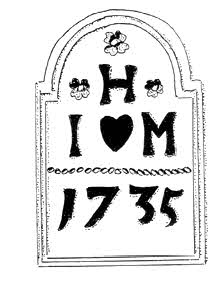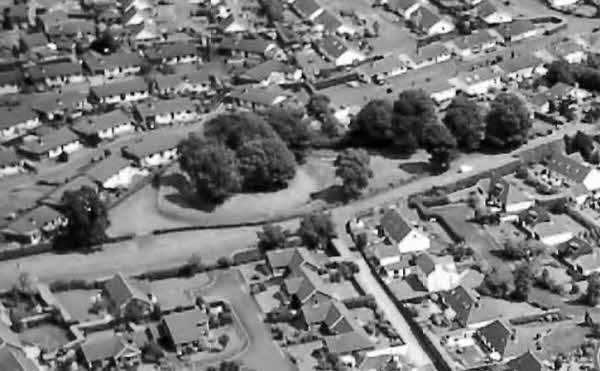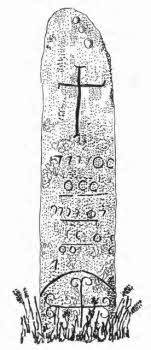- First Steps
- Footprints
- The Native
- The Warrior
- The Gaelic Chieftain
- THE Gardener
- The Quiet Builder
- The Lady
- The Reverend
- The Sinner
- The Dying Methodist
- The Homecoming Earl
- The Soldier - Statesman
- The Hero
- The Farm Labourer
- The Woman Preacher
- The Jew
- The Orange Man
- The Mollycoddled Boy
- When Footprints Fade
- Acknowledgements
- Other Historical Materials
- Video
External links
First Steps
Storytelling to children has been an enormous part of my life but never stories quite like these. My old history teacher would be astounded if he knew his clueless pupil was now telling history stories. Someone has suggested that children are generally excited about history but often lose that excitement when they get to school. I wonder if that happened to me? Coming to Moira in 1995 awakened an interest in the past. History was no longer about remembering the dates of battles and endless lists of Kings, but about places I could visit, things I could touch and real people who had lived in Moira.
For the past few years I have researched and recorded the history of this village and had some opportunities to share this in public meetings and in the local primary school. Some friends suggested I should put it in print but I thought most people would find history books boring. However, as I learned more of Moira through the ages, I found stories jumping off the dusty pages and I wanted to tell those stories. That is where this little book was born.
Footprints over Moira is a book of short stories, either relating to
real historical characters or using imaginary characters to tell real
historical stories. All of them are placed in or close to Moira. Most
stories are written in chronological order but each one stands alone,
allowing stories to be read individually. Every care has been taken to
ensure the stories are as historically
accurate as possible.
 |
|
Wall stone on 90 Main Street |
I am grateful to all who have inspired, advised and helped with the production of this small volume. It was through reading A Historical Handbook by Rev. Canon C.R.J. Rudd, former Rector of Moira, that my interest in the local history of Moira was first aroused. I have had good advice from Mr. Horace Reid from Ballynahinch, a gifted amateur historian with a great knowledge of the Rawdon family history. Friends have been very helpful: Margaret advised from a community perspective: Philip and Gillian checked the manuscript for errors and readability. My family has been of enormous help: Brian has painstakingly and skilfully prepared the manuscript and cover for printing and Gordon and his wife Gillian have provided the beautiful line drawings. Christian Fellowship Trust has been encouraging and generous in making this booklet a reality and in allowing me to share it as a gift to Moira. And then there are those volunteers who have offered to help me distribute it in the community. To everyone I offer my heartfelt thanks and I hope that as you read these stories, you will be enlightened and enthused about those who walked this way before us.
My love of storytelling began with the greatest story of all - the story of Jesus and His love for us. So, woven within these pages, you will find His story. As we follow footprints, I pray that you will meet Him who made all things. He left His own footprints on this earth and calls us to follow Him, saying:
“I have come that they may have life, and have it to the full.”
John 10v10.
David McFarland
Moira 2011
Footprints
I sat lazily in the coffee shop watching passers-by. Someone had spilled water outside the shop next door. Wet footprints began to form on the dry pavement. Some people left large prints and some left small; some passed quickly leaving few prints and some stopped for a time leaving multiple marks. I noticed that as time passed the marks merged, becoming practically indistinguishable; yet everyone who walked through the puddle had left his individual imprint, even if those prints were now hidden.
I thought how life was like that. We all tread this earth and leave footprints; some are sizeable prints and some small; a few prints remain for a long time and others disappear so fast. We spend our lives treading on the footprints of others and easily forget the imprint made by those who have gone before us.
Over the years, a great many footprints have been left over Moira. The small County Down village has had a remarkable impact on social, political, economic, religious and military life in Ireland, the United Kingdom and across the world; it is an impact that has almost been hidden under centuries of footprints.
This little volume is an attempt to follow the footprints of some who
walked here in bygone days. Some were residents and others were
visitors; some came to destroy life and some came to improve it; a few
were extremely wealthy aristocrats but many laboured in extreme poverty;
some lie today in impressive vaults but thousands lie in unmarked
graves. All walked over Moira and have gone, but we will learn much from
them as we follow their footprints.
![]()
The Native
The crimson sun was slowly setting over Loch Echach. An ethereal mist gathered in the valley of the Lagáin. Áedán hurried his goats and his children along. In this dense, shadowy forest, it was important to be home before dark.
Home was a small man-made settlement on the high ground. Earthen embankments, painstakingly dug, were strongly fortified with wooden palisades. Only inside the rath or fort was it safe for humans and their livestock to sleep.
This hill area, with the loch on the west and the river on the east, became known as Magh-Rath, the plain of the ring forts. It would later be called Moirath, Moyrah and Moyra. Today we call this place Moira, lying between Lough Neagh and the River Lagan.
Growth in population and the ensuing development of the land over the years has left little to remind us of early life in this area. Archaeologists have discovered a ruined primitive dwelling-place in the townland of Drumbane. It is a crannog; a man made island or dwelling built on stilts, usually in a lake or bog.
However, some signs of our early ancestors still remain. We are familiar with the numerous earthen raths or ring-forts around Moira. The best preserved example and perhaps most visible is the Rough Fort on the Old Kilmore Road. The Green at Claremont is all that is left of another of these ring forts. One close to the quarry on the Lurgan Road has long since been levelled. The rath in the town-land of Aughnafosker, just behind Glebe Gardens, is called Pretty Mary’s Fort. It is a good specimen of a multi-vallate ring-fort or a fort with many ditches. As many as twenty-four forts have long since been levelled, including a large one on the highest ground of Ballymackeonan.
Centuries ago this place was inhabited by people more like us than we imagine. Áedán and his fellow natives have left their footprints all over this land. Right here where they lived and worked is the place where they are buried. They remind us that life is transient; that we are not here forever. Like the ethereal mist over the Lagan, we too will fade away and will leave little but footprints in Moira.
“What is your life? You are a mist that appears for a little while and then vanishes.” James 4:14.
“We are here for only a moment, visitors and strangers in the land as our ancestors were before us. Our days on earth are like a passing shadow, gone so soon without a trace.” 1 Chronicles 29:15. (NLT)
“When Adam sinned, sin entered the world. Adam’s sin brought death,
so death spread to everyone, for everyone sinned.” Romans 5:12. (NLT)

Aerial view of Rough Fort
The Warrior
Artagan was far from his home in the Hebrides in Argyle.
His stomach still ached from the seasickness he suffered on the voyage
to Dunseverick. Now his limbs ached as he marched
with thousands of others through the Ulster Scottish Kingdom of Dalriada
in the North East corner of Ulster. He was following Congal Cláen, their
one-eyed leader, on the royal road that led from Dunseverick to Tara and
there was a long way still to go. It was 637 AD.
Ten years earlier Congal Cláen of the Cruthin had become over-King of all Ulster. But after killing the Uí Néill high King Suibne Menn of the Clan Owen and then being defeated by Domnall, the new high king, Congal had fled to Scotland, vowing to return. Artagan was one of Congal’s recruits, along with a host of other Scots, Anglo-Saxons and Britons, returning to get revenge.
It was now Monday 23rd June 637. Domnall advanced from Tara and was camped at a ford on the Lagan just outside Moira. It is said that there were fifty thousand men on either side. The night before battle, Artagan sat on the hillside and stared across at the hordes on the other side. Would he ever see his beloved Hebrides again?
What happened over the next six days has been described as one of the most blood-thirsty battles in early Irish History. Congal and most of his army were killed. Those that could still run fled over the Ford Ath-ornagh (Thornbrook), up the ascent of Trummery, and in the direction of the Killultagh Woods, near Ballinderry.
An eighteenth century report states, "just below the kilns, exactly
where it was possible to ford the Lagan River there stood a mound which
a few years ago was discovered to consist almost entirely
of human remains, bearing marks of calcination, evidently of those who
had been slain in some great battle.” When the Ulster Railway was being
constructed in 1841, great quantities of bones were discovered,
particularly in the cutting just below Trummery old graveyard. All these
bones may well have been the remains of men and horses killed in the
battle.
The battle has left marks on Moira to this day in the names of the townlands. Aughnafosker means the ‘field of slaughter’ and Carnalbanagh means the ‘Scotsman’s grave.’ A pillar stone with a crude cross and some circles on it once stood on the rath in Claremont, signifying the graves of Scottish Princes killed at Moira but vandals destroyed it two hundred years ago.
Sir Samuel Ferguson wrote an epic poem in 1872 called “Congal: A Poem in Five Books.” In one verse he depicts Congal staring at defeat and death –
 ‘My sins, said Congal, and my deeds of strike and bloodshed seem
‘My sins, said Congal, and my deeds of strike and bloodshed seem
No longer mine, but as the shapes and shadows of a dream
And I myself, as one oppressed with life’s deceptive shows,
Awaking only now to life, when life is at its close.’’
Life was at its close for Congal and for many of his followers but did any one of them know that this life is not the end for all of us?
And as it is appointed unto men once to die, but after this the
judgment: so Christ was once offered to bear the sins of many; and unto
them that look for him shall he appear the second time without sin unto
salvation.
Hebrews 9:27-28. (KJV)
For God so loved the world that he gave his one and only Son, that
whoever believes in him shall not perish but have eternal life.
John 3:16.
Where, O death, is your victory? Where, O death, is your sting? The
sting of death is sin, and the power of sin is the law. But thanks be to
God! He gives us the victory through our Lord Jesus
Christ. 1 Corinthians 15:55-57.
